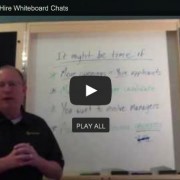How Text Messaging Fills Positions Faster
Move over Zoom. The pandemic has bumped up another mode of communication: texting. Overall, 50 percent of the population is using text more often since the pandemic began. And if you’re one of the few recruiters not using text messaging for hiring, I might be SMH (shaking my head) at you.
Texting has been on the rise since the first 10-year old Millennial received a cell phone—check that—since the first two 10-year old Millennials received a cell phone. Businesses have been marketing with text for years and have seen huge results. Success with text marketing is no surprise considering a read rate of 97 percent within 15 minutes.
Okay, so maybe every American sends and receives about a 100 texts per day. But does that really make text messaging effective for recruiting and hiring?
Text Messaging Is Effective
Just ask Home Depot. The home improvement giant saw a 50 percent increase in response rate for texting applicants versus other methods since implementing a robust text recruiting strategy.
Like working from home and Zoom calls, text messaging in business recruiting is here to stay. There are just too many benefits of text recruiting, including speed and efficiency.
Both the hiring manager and the applicant save time composing a text versus an email. And unlike email, nearly everyone reads their texts, oftentimes within 15 minutes.
And if you’re still wondering is email or text messaging more effective for response rates, 82 percent of people turn on notifications from their text messaging apps. That’s probably much more than email considering only 27 percent of those who primarily use their phone to check email do so as the emails arrive.
Busy recruiters can manage multiple conversations in less time. That kind of efficiency is especially helpful for positions that typically have a high turnover rate. If you hire for these high turnover jobs often, then pre-screening may become one of your favorite benefits of text recruiting.
Pre-screening applicants over the phone can be time-consuming. But what if you could start winnowing down your hiring choice with a text conversation? You could get a lot of common deal breakers out of the way, such as verifying the candidate is still looking for a job and has reliable transportation.
The speed and efficiency of texting can reduce your time-to-hire metrics, especially for your high turnover, hourly positions. If you’re still wondering is text messaging acceptable, just ask the 86 percent of Millennials prefer texting during the recruiting process.
Hiring Problems That Text Messaging Solves
Text messaging has grown from a vehicle for informal teen chats to a commonplace form of communication in all areas of life. Texting efficiently relays information without the time-consuming small talk of phoning. It’s only natural that texting has made its way into the recruiter’s toolbox as an effective solution to several problems.
Text messaging applicants is more efficient than phone interviewing. Phoning potential interviewees is time-consuming. You’re unable to do anything else while you’re dialing, waiting for an answer, and actually talking to the candidate. Multiply the process by the several calls required for each open position and you’re easily losing hours in the first step of the interview process.
When you text message job candidates, you can quickly narrow down your choices. Save time by text messaging screening questions concerning a candidate’s availability and access to transportation. When you’re ready, you can schedule candidate interviews with text messaging.
Text messaging will reduce applicant ghosting. Increasingly, job applicants don’t respond to traditional communications. Most email messages—80 percent—remain unread. Entry-level job seekers do not always have email. Most people don’t answer calls from unknown callers, and many voicemail boxes are full or not set up.
On the other hand, nearly all texts are read within 15 minutes of being sent. Millennials, especially, are open to responding to texts from unknown senders. Typing away on a smartphone doesn’t deter applicants who already use their phones to apply for jobs.
Phone calls and emails can’t match the speed and effectiveness text messaging offers. But if you don’t have applicant tracking software to manage your text messaging efforts, you risk appearing unprofessional.
How to Text Message Professionally
If you didn’t know what SMH meant before reading this article, don’t feel bad; I didn’t either. Luckily, neither of us needs to be as fluent as a teenager in texting slang. If you’re recruiting via text, then you want to keep it as professional as possible. Adhering to professional text messaging etiquette while recruiting will reinforce a positive impression of your company.
- Ask for permission to text during the application process. While it may be convenient for you, it may be a hassle for your applicant. Think of asking first as the golden rule for any business wishing to communicate via text.
- Identify yourself, your company, and the reason for your text. Candidates have probably applied to multiple companies. Clearly identifying yourself and your purpose prevents any confusion. Using a text messaging template for recruiting will help you keep it professional.
- Avoid texting slang. Always spell the word rather than rely on acronyms. Use proper punctuation and capitalize the first letter of every sentence. Never, ever use emojis.
- Be personable. Don’t let your applicant feel as if she is talking to a chatbot. Address her by name and thank her for her time. Remember, your text is her first indication of how the company will treat her if she becomes an employee.
You can use applicant tracking software to create a professional texting strategy. A custom online application can ask the applicant for permission to text. From there, you can create text messaging templates for your hiring needs. You can even set the text messaging time of day using applicant tracking software.
Develop a Text Recruiting Strategy
Incorporating text messaging as part of your talent strategy can improve your time-to-hire metrics. Applicant tracking software that includes text recruiting campaigns will streamline and organize your efforts. Your strategy should develop text messaging cadences to avoid overwhelming the candidate with too many messages. You’ll reduce applicant ghosting significantly when you combine text messaging with email and phone. Finally, text messaging templates for hiring will help ensure your text recruiting campaign reflects your brand’s voice.
Text messaging was rising long before the pandemic. Now, social distancing means people are texting 50 percent more than before. Covid made texting mainstream, much like remote work and Zoom meetings. It makes more sense than ever to use texting in your recruiting campaigns.
Are you unsure of how to start engaging applicants on their mobile devices? Download our guide, Leveraging Text Recruiting to Engage Job Seekers. You’ll learn how to measure and maximize your mobile recruiting effectiveness.
Photo by Domingo Alvarez E on Unsplash










